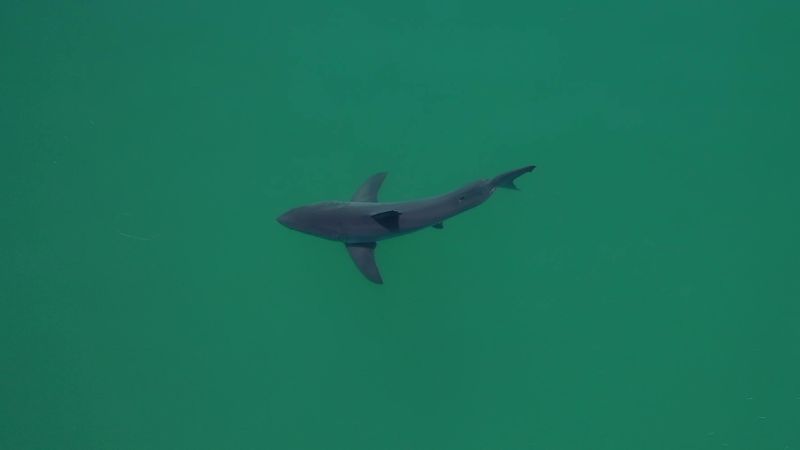CNN
—
On summer mornings, local kids like to gather at Padaro Beach in California to learn to surf in gentle whitewater waves. A few years ago, the beach also became a popular hangout for juvenile great white sharks.
That led to the launch of SharkEye, an initiative at the University of California Santa Barbara’s Benioff Ocean Science Laboratory (BOSL), which uses drones to monitor what’s happening beneath the waves.
If a shark is spotted, SharkEye sends a text to the 80-or-so people who have signed up for alerts, including local lifeguards, surf shop owners, and the parents of children who take lessons.
In recent years, other initiatives have seen officials and lifeguards from New York to Sydney using drones to keep beachgoers safe, monitoring video streamed from a camera. That requires a pilot to stay focused on a screen, contending with choppy water and glare from the sun, to differentiate sharks from paddleboarders, seals, and undulating kelp strands. One study found that human-monitored drones only detect sharks about 60% of the time.
SharkEye – part research program, part community safety tool – is using the video it collects to analyze shark behavior. It’s also feeding its footage into a computer vision machine learning model – a type of artificial intelligence (AI) technology that enables computers to glean information from images and videos – to train it to detect great white sharks near Padaro Beach, close to the city of Santa Barbara.
“Automating shark detection … can (also) be really helpful for a lot of communities outside of ours here in California,” Neil Nathan, a project scientist with BOSL, who graduated from Stanford University with a master’s degree in environmental studies a few years ago, told CNN.
A rise in the popularity of drones, and the proliferation of social media, may make it seem like sharks are everywhere. It doesn’t help that warming ocean temperatures are pushing sharks into new habitats, and that juvenile great whites, which can grow to about eight to 10 feet long, like to hang out near the shore, making them more visible to beachgoers.
Yet shark attacks are rare. In 2023, 69 people globally were at the receiving end of unprovoked bites – which is in line with the average of 63 annual incidents between 2018 and 2022. Just 10 of them died, according to the Florida Museum of Natural History’s International Shark Attack File.
Although there hasn’t been a fatal attack recorded at Padaro Beach, some community members were concerned when sharks began loitering there.
That’s why SharkEye has been regularly running drone flights to monitor the coastline for about five years, once spotting 15 juvenile great white sharks in a single day.
Early tests indicate that the AI technology is already performing “incredibly well,” detecting most sharks a human can, and sometimes sharks that a human missed, perhaps because it was swimming too deep to spot easily, said Nathan.
This summer, the project began field testing its technology by pitting drone pilots against AI. Its pilot surveys the area and counts the number of sharks she spots. Then SharkEye’s model analyzes the video to see how many sharks it can find.
Today, the community alerts are based on human analysis. If all goes swimmingly, those reports may become AI-assisted – with manual monitoring and checks – by the end of the season, or the start of next summer, said Nathan. In the future, the process may even become totally automated, making it faster and potentially more accurate.
AI and wildlife
AI technologies are being harnessed in myriad ways to mitigate human-wildlife conflict. In India, AI-enabled cameras are alerting villagers when tigers are closing in on their livestock, and in Australia, technology is being used to manage some of its dangerous creatures.
Ripper Corp and academics pioneered what they say are the first shark identification algorithms in the world, which were put to use in drones a few years ago. The latest version of the software is being tested across the Australian state of Queensland, Mexico and the Caribbean to detect sharks and crocodiles.
However, AI is not yet used widely for shark detection. Surf Life Saving New South Wales, which protects dozens of beaches along the state’s coast, including Sydney’s iconic Bondi Beach, uses drones in 50 locations. But a spokesperson told CNN that their drones aren’t currently utilizing AI.
A group from one Australian university that worked on AI-enhanced shark-spotting tools wrote in 2022 that the technology can struggle when encountering conditions that weren’t present in the training data.
SharkEye plans to make its model free and available for researchers to amend or build on, and to create an AI-powered app that’s easy for people like lifeguards and drone hobbyists to run their footage through. That could help keep people safe, but also allow humans to better understand and protect sharks.
Nathan said it remains to be seen how much retraining will be required for SharkEye to expand to other locations. He’s hopeful that if drone pilots fly at the same speed and altitude, they won’t have too many issues elsewhere in California, where the coastline is similar.
Officials in Honolulu said this month that they’re considering launching a drone shark surveillance program, according to local media. If SharkEye’s technology were to be used in places like Hawaii, where tiger sharks are the biggest concern, and the hue of the water differs, more retraining might be necessary. But Nathan said that SharkEye is open to working with other localities to help adapt the model.
“Communities want to have that knowledge and that awareness so it’s easier to more safely share the water with these creatures,” said Nathan. “Sharks are an incredible species that we still are always learning new things about.”









 Unions
Unions Gavin Newsom
Gavin Newsom





















